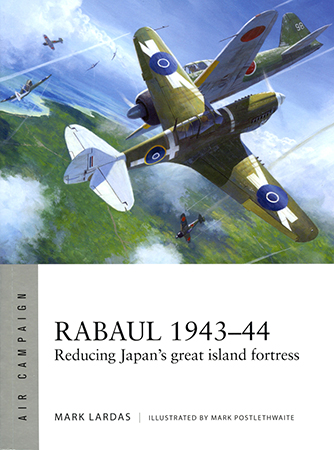
Rabaul 1943-44 Book Review
By David L. Veres
| Date of Review | March 2018 | Title | Rabaul 1943-44 |
|---|---|---|---|
| Author | Mark Postlethwaite | Publisher | Osprey Publishing |
| Published | 2018 | ISBN | 9781472822444 |
| Format | 96 pages, softbound | MSRP (USD) | $20.00 |
Review
During World War II's Pacific fighting, the Allies typically employed airpower to "isolate and immobilize" Japanese forces – then dispatched ground troops to crush enemy remnants.
But to defeat Japan's stronghold at Rabaul, the Allies would instead seize surrounding islands, "build airfields on them", and "ring Rabaul" – the most heavily defended Japanese citadel in the Southwest Pacific – with swarms of attacking Allied aircraft.
Airpower – including US Navy carrier-based assets – would force Japan into an unwinnable battle of attrition. Air superiority would ultimately neutralize the Imperial enclave.
That's the thrust of Rabaul 1943-44 – second installment in Osprey Publishing's new "Air Campaign" series.
After a stage-setting introduction and chronology, contents chronicle the campaign's background and, almost day-by-day, its actions:
- Attackers' Capabilities
- Defenders' Capabilities
- Campaign Objectives
- The Campaign
Subtitled "Reducing Japan's great island fortress", author Mark Lardas' slim, 96-page study explores the campaign's aircraft, basing, facilities, reserves, personnel, tactics, and strategy – Allied and Japanese.
USAAF Fifth Air Force, RAAF, RNZAF, USMC, and USN. IJAAF and IJNAF. The campaign also saw combat debuts of, for instance, Curtiss' SB2C Helldiver and Interstate's TDR-1 combat drone.
Allied attacks systematically ravished Rabaul. Facilities. Defenses. Structures. Supply dumps. Warehouses. Repair shops. Power plants. Communications facilities. Naval basing capabilities. Offensive airpower capacities. And more.
Food stocks and production, however, were not destroyed. And Japan's garrison were able to feed themselves – right up to their October 1946 repatriation. "Functionally", Lardas notes, Rabaul continued as "an open-air prisoner of war camp, with the inmates running it, and the jailers not obligated to feed, house, and clothe their charges."
"The Japanese waited for an invasion which never came." Bypassed and crippled, isolated and immobilized, the Imperial stronghold surrendered to Australia 6 Sept 1945.
Illuminating "aftermath" and "analysis" sections conclude coverage. Photos, maps, battle schematics, action paintings, and extended captions augment the account. And a selected bibliography and index wrap things up.
A handy little history. And an informative, entertaining effort. But I'd hardly call RAAF Wirraways "fighters". And I guess the Naruto and Narato were separate ships. Or were they?
Recommended!
My sincere thanks to Osprey Publishing for this review sample!







